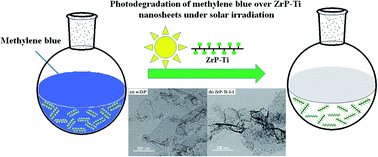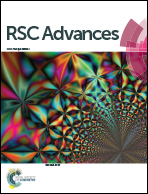Titanium functionalized α-zirconium phosphate single layer nanosheets for photocatalyst applications
Abstract
Titanium species were immobilized on α-ZrP nanosheets (ZrP–Ti) using a modified post-grafting method. The obtained ZrP–Ti composites were characterized via Fourier transform infrared (FTIR) spectroscopy, X-ray diffraction (XRD), X-ray photoelectron spectroscopy (XPS), transmission electron microscopy (TEM), ultraviolet-visible (UV-vis) absorption spectroscopy, photoluminescence spectroscopy (PL), and scanning electron microscopy (SEM). Titanium species in the form of TiO2−x clusters with an average particle size of 2–5 nm were grafted on α-ZrP nanosheets via chemical bonding with P element. These ZrP–Ti composites could be well dispersed in polar solvents to ensure that the TiO2−x clusters bonded on both faces of the nanosheets were accessible. The ZrP–Ti composites presented enhanced visible-light absorption properties compared with that of pure TiO2. These features allowed them to exhibit better photocatalytic activities for the photodegradation of methylene blue (MB) under solar irradiation. The TiO2−x clusters tended to aggregate into anatase phase TiO2 when the molar ratio of P/Ti exceeded 1 : 1, and this reversed the advantage in their photocatalytic activities. The best MB degradation efficiency of 100% with the apparent rate constant of 0.054 min−1 was achieved over the ZrP–Ti composite with the P/Ti molar ratio of 1 : 1.


 Please wait while we load your content...
Please wait while we load your content...